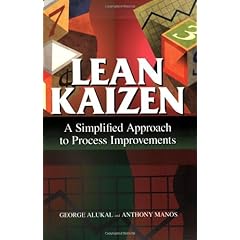Name of Book: Lean Kaizen: A Simplified Approach to Process Improvements
Authors: George Alukal & Anthony Manos
Publication Date: 2006
Reviewed By: Luke Van Dongen, February 2007
Book description: what's the key message? This book is published by the American Society for Quality (ASQ) and is based on the authors' work developing and delivering a two-day course in lean enterprise and an additional one-day course focusing on kaizen. It is a practical book that aims to provide a hands-on approach to organizing for and conducting kaizen events.
How does it contribute to the lean knowledge base? Lean Kaizen does not intend to provide new information, but contributes to the lean knowledge base by effectively consolidating experiences and examples into a concise body of work that is easy to read, understand and follow. The framework suggested is simple and is well supported by lean theory and practical application in a variety of industries and settings.
What are the highlights? What works? Alukal and Manos share a great deal of personal experience with kaizen and have included a wealth of practical knowledge. These ‘lessons learned' collectively contribute to a realistic understanding of lean as a process, not a quick fix and are relevant to many challenges lean leaders are likely to face. Practical advice prevails and there are multiple suggestions to help deal with obstacles, challenges and opposition to new thinking, new methods and implementing change.
These ‘lessons learned' are particularly prevalent and applicable to the soft side of kaizen events including involving people in the process, dealing with resistance from various stakeholders, answering common questions, sustaining results and compelling action. The authors pay particular attention to the importance of keeping the kaizen team to a manageable size while also involving as many people as possible through various forms of communication to solicit ideas, suggestions for improvement and support.
The book proposes a structure that stresses preparation, collaboration, inclusion and clearly defined roles and responsibilities. It stresses that immediate implementation of improvements is desired whenever possible and continually reminds readers that a “not-so-perfect solution” implemented today is better than a perfect solution that is late. Anyone experienced and involved in leading lean transformations would most certainly support these positions.
What are the weaknesses? What's missing? Lean Kaizen does a great job of explaining how to hold a single Kaizen event. The importance of creating a strategy and sustained effort to link individual improvement efforts with a holistic vision for an activity, function or process is missing. While significant, this is somewhat understandable as the book is not aimed at managers or leaders responsible for setting broad strategic objectives and goals.
The intended audience for the book includes, “quality or operational professionals who want to start their lean journey at work or to enhance their career opportunities.” The first chapter's introduction to lean should serve this audience well, however the remainder of the book assumes a much greater base of knowledge than someone new to lean can learn from these few pages. As an example Chapter 5 suggests that the current state VSM is reviewed as a source of data when starting the kaizen process. Current state VSMs are likely not in place in organizations that are only just starting their lean journey; if they are, it is unlikely someone new to lean would not be able to effectively use information from the map without any prior experience or exposure to symbols, notations and data boxes.
The level of background information on lean provided does keep the book short and focused on the kaizen process and because of this should not be changed considerably. Addressing this concern could be easily achieved with an additional paragraph or two focused on framing lean as a subject worthy of further exploration with suggestions for additional resources included. This would help people who are new to lean but work in organizations where there is lean activity as well as individuals in organizations entirely new to lean ideas and tools.
Another unrelated improvement idea concerns the document templates provided on the included CD. The layout of these tools and templates is good and will help anyone organize and track progress through a Kaizen event or activity. However, the documents on the CD are in Portable Document (.pdf) format and can't readily be used. Most people will need to set up their own files using a spreadsheet or word processing application in order to customize, expanded on and use them as tools. The files themselves are exact duplicates of layouts and templates printed in the appendices and provide little if any added value.
How should I read this to get the most out of it? This book will be most valuable to people and organizations who have some exposure to kaizen activities and are ready to begin organizing and conducting events. The Eight-Week cycle and suggested activities and tasks for each week provide a great standard from which to start.
The project examples in the book cover a wide variety of manufacturing, service and office projects and are a good source of ideas and solutions. Referring back to these may provide additional inspiration and practical advice when working with your teams on improvement events within your organization. The pictures and excellent description of actions make it very easy to understand the why and how of lean tools in several diverse applications.
——————————————
For more reviews in this “standard work” format, please visit “The Lean Library.”
What do you think? Please scroll down (or click) to post a comment. Or please share the post with your thoughts on LinkedIn – and follow me or connect with me there.
Did you like this post? Make sure you don't miss a post or podcast — Subscribe to get notified about posts via email daily or weekly.
Check out my latest book, The Mistakes That Make Us: Cultivating a Culture of Learning and Innovation:









